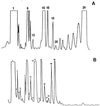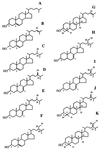Sterols of Pneumocystis carinii hominis organisms isolated from human lungs
- PMID: 10548595
- PMCID: PMC95807
- DOI: 10.1128/CDLI.6.6.970-976.1999
Sterols of Pneumocystis carinii hominis organisms isolated from human lungs
Erratum in
- Clin Diagn Lab Immunol 2000 Jan;7(1):129
Abstract
The opportunistic pathogen Pneumocystis carinii causes pneumonia (P. carinii pneumonia, or PCP) in immunocompromised individuals such as AIDS patients. Rat-derived P. carinii carinii organisms have distinct sterols which are not synthesized by mammals and not found in other microbes infecting mammalian lungs. The dominant sterol present in the organism is cholesterol (which is believed to be scavenged from the host), but other sterols in P. carinii carinii have an alkyl group at C-24 of the sterol side chain (C(28) and C(29) 24-alkylsterols) and a double bond at C-7 of the nucleus. Recently, pneumocysterol (C(32)), which is essentially lanosterol with a C-24 ethylidene group, was detected in lipids extracted from a formalin-fixed human P. carinii-infected lung, and its structures were elucidated by gas-liquid chromatography, mass spectrometry, and nuclear magnetic resonance spectrometry in conjunction with analyses of chemically synthesized authentic standards. The sterol composition of isolated P. carinii hominis organisms has yet to be reported. If P. carinii from animal models is to be used for identifying potential drug targets and for developing chemotherapeutic approaches to clear human infections, it is important to determine whether the 24-alkylsterols of organisms found in rats are also present in organisms in humans. In the present study, sterol analyses of P. carinii hominis organisms isolated from cryopreserved human P. carinii-infected lungs and from bronchoalveolar lavage fluid were performed. Several of the same distinct sterols (e.g., fungisterol and methylcholest-7-ene-3beta-ol) previously identified in P. carinii carinii were also present in organisms isolated from human specimens. Pneumocysterol was detected in only some of the samples.
Figures


Similar articles
-
C27 to C32 sterols found in Pneumocystis, an opportunistic pathogen of immunocompromised mammals.Lipids. 2000 Mar;35(3):317-24. doi: 10.1007/s11745-000-0528-8. Lipids. 2000. PMID: 10783009
-
Sterol metabolism in the opportunistic pathogen Pneumocystis: advances and new insights.Lipids. 2004 Aug;39(8):753-61. doi: 10.1007/s11745-004-1292-5. Lipids. 2004. PMID: 15638243 Review.
-
Pneumocysterol [(24Z)-ethylidenelanost-8-en-3beta-ol], a rare sterol detected in the opportunistic pathogen Pneumocystis carinii hominis: structural identity and chemical synthesis.Proc Natl Acad Sci U S A. 1999 Jan 5;96(1):97-102. doi: 10.1073/pnas.96.1.97. Proc Natl Acad Sci U S A. 1999. PMID: 9874778 Free PMC article.
-
Comprehensive and definitive structural identities of Pneumocystis carinii sterols.J Lipid Res. 2002 Jul;43(7):1114-24. doi: 10.1194/jlr.m200113-jlr200. J Lipid Res. 2002. PMID: 12091496
-
Is Pneumocystis a plant?J Eukaryot Microbiol. 2002 Sep-Oct;49(5):367-73. doi: 10.1111/j.1550-7408.2002.tb00214.x. J Eukaryot Microbiol. 2002. PMID: 12425523 Review.
Cited by
-
A Molecular Window into the Biology and Epidemiology of Pneumocystis spp.Clin Microbiol Rev. 2018 Jun 13;31(3):e00009-18. doi: 10.1128/CMR.00009-18. Print 2018 Jul. Clin Microbiol Rev. 2018. PMID: 29899010 Free PMC article. Review.
-
Heterogeneity of Pneumocystis sterol profiles of samples from different sites in the same pair of lungs suggests coinfection by distinct organism populations.J Clin Microbiol. 2001 Mar;39(3):1137-9. doi: 10.1128/JCM.39.3.1137-1139.2001. J Clin Microbiol. 2001. PMID: 11230442 Free PMC article.
-
PCR-based diagnosis of human fungal infections.Expert Rev Anti Infect Ther. 2009 Dec;7(10):1201-21. doi: 10.1586/eri.09.104. Expert Rev Anti Infect Ther. 2009. PMID: 19968513 Free PMC article. Review.
-
C27 to C32 sterols found in Pneumocystis, an opportunistic pathogen of immunocompromised mammals.Lipids. 2000 Mar;35(3):317-24. doi: 10.1007/s11745-000-0528-8. Lipids. 2000. PMID: 10783009
-
Sterol metabolism in the opportunistic pathogen Pneumocystis: advances and new insights.Lipids. 2004 Aug;39(8):753-61. doi: 10.1007/s11745-004-1292-5. Lipids. 2004. PMID: 15638243 Review.
References
-
- Amit, Z., R. P. Baughman, and E. S. Kaneshiro. Pneumocystis carinii sterols in human bronchoalveolar lavage fluid. Submitted for publication.
-
- Banerji S, Lugli E B, Wakefield A E. Identification of two genetically distinct strains of Pneumocystis carinii in infected ferret lungs. J Eukaryot Microbiol. 1994;41:73S. - PubMed
-
- Bartlett M S, Eichboltz R, Smith J W. Antimicrobial susceptibility of Pneumocystis carinii in culture. Diagn Microbiol Infect Dis. 1985;3:381–387. - PubMed
-
- Baughman R P, Dohn M N, Frame P T. The continuing utility of bronchoalveolar lavage to diagnose opportunistic infection in AIDS patients. Am J Med. 1994;97:515–522. - PubMed
-
- Baughman R P, Dohn M N, Loudon R G, Frame P T. Bronchoscopy with bronchoalveolar lavage in tuberculosis and fungal infections. Chest. 1991;99:92–97. - PubMed
Publication types
MeSH terms
Substances
Grants and funding
LinkOut - more resources
Full Text Sources
Miscellaneous

